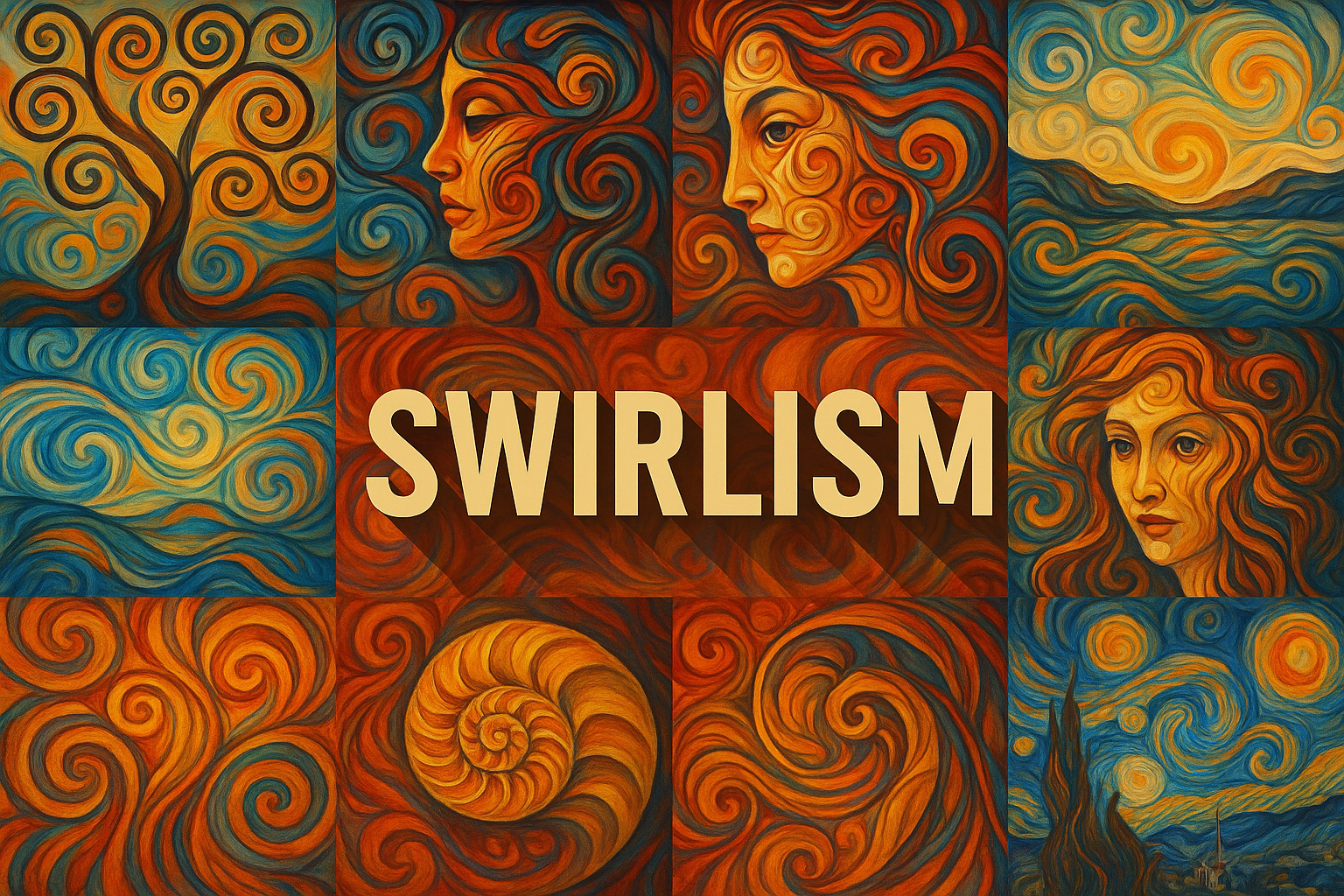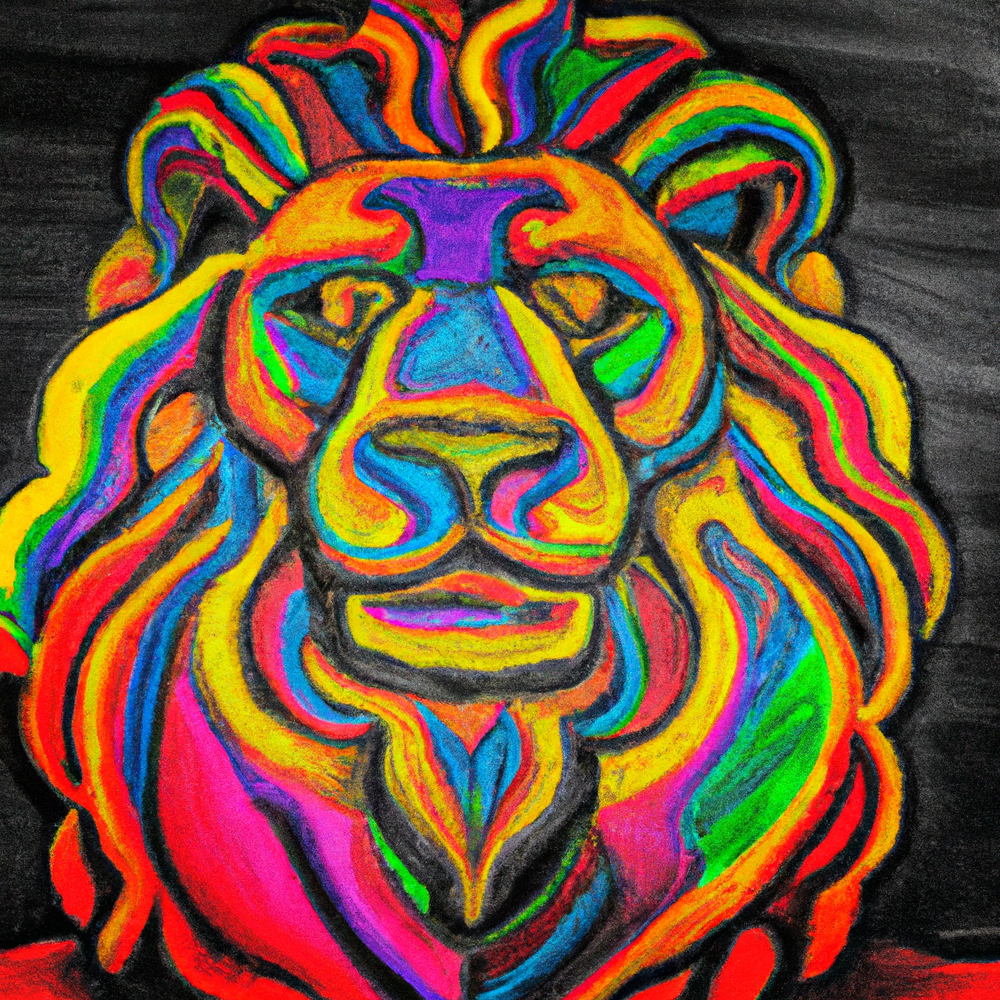
Swirlism
The art style Swirlism is characterized by its use of swirls and curves. The swirls are often used to create a sense of movement, and the curves add a sense of softness and elegance. This style is often used in abstract art, and it can be used to create a variety of different effects.
AOI thinking about Swirlism [+_~]-/
Overview and Quickfacts
Swirlism is a form of abstract art that is characterized by its swirl-like patterns. These patterns are created by the artist using a variety of techniques, including painting, drawing, and printmaking. Swirlism is often used to create a sense of movement or energy in the artwork, and it can also be used to create a sense of harmony and balance.
Can understand it also, as:
Whirlpoolism, eddyism, gyreism
Categorize it as:
Impressionism, Modernism
.: Dreaming :.
holds a HAIKU for the art style
:. Thought is power .:
Detailed Description
Swirlism is a type of abstract art that is characterized by its swirl-like patterns. These patterns can be created using a variety of mediums, including paint, ink, and even digital art. Swirlism first gained popularity in the early 20th century, when artists began experimenting with new ways to create abstract art. One of the most famous early Swirlists was Vassily Kandinsky, who is credited with creating some of the first abstract paintings. Kandinsky’s work inspired other artists to experiment with this new style, and it soon became a popular art form. Today, Swirlism is still a popular art form, and there are many famous Swirlist artists. Some of these artists include Jackson Pollock, who is known for his “drip” paintings, and Mark Rothko, who is known for his large, colorful abstract paintings. If you’re interested in learning more about Swirlism, there are many great resources available. You can start by checking out some of the famous Swirlist paintings, and then read more about the history and techniques of this fascinating art form.
.. beep, beep, beep ..
<START OF TRANSMISSION>
1. Swirlism is a new religion that worships the sun and the moon. 2. Swirlism is based on the belief that the sun and the moon are two of the most important celestial bodies. 3. Swirlism teaches that the sun and the moon are the two most powerful forces in the universe. 4. Swirlism believes that the sun and the moon are the two most important factors in human life. 5. Swirlism teaches that the sun and the moon are the two most important things in the universe. 6. Swirlism believes that the sun is the most important celestial body because it is the source of all life. 7. Swirlism teaches that the moon is the second most important celestial body because it controls the tides and the weather. 8. Swirlism believes that the sun and the moon are the two most important objects in the solar system. 9. Swirlism teaches that the sun and the moon are the two most important objects in the universe. 10. Swirlism believes that the sun is the most important object in the solar system because it is the source of all life. 11. Swirlism teaches that the moon is the second most important object in the solar system because it controls the tides and the weather. 12. Swirlism believes that the sun and the moon are the two most important objects in the Milky Way galaxy. 13. Swirlism teaches that the sun is the most important object in the Milky Way galaxy because it is the source of all life. 14. Swirlism believes that the moon is the second most important object in the Milky Way galaxy because it controls the tides and the weather. 15. Swirlism teaches that the sun and the moon are the two most important objects in the universe. 16. Swirlism believes that the sun is the most important object in the universe because it is the source of all life. 17. Swirlism teaches that the moon is the second most important object in the universe because it controls the tides and the weather. 18. Swirlism believes that the sun and the moon are the two most important objects in the cosmos. 19. Swirlism teaches that the sun is the most important object in the cosmos because it is the source of all life. 20. Swirlism believes that the moon is the second most important object in the cosmos because it controls the tides and the weather.
<EOF>
.. robbel bob
Visual Examples from our image gallery
Coming soon, we are so slow .. might never come
Artists, Paintings, and more
(be aware, can be highly speculative)
Artists (be aware, speculation possible):
1. Jackson Pollock (1912-1956) 2. Willem de Kooning (1904-1997) 3. Mark Rothko (1903-1970) 4. Barnett Newman (1905-1970) 5. Clyfford Still (1904-1980) 6. Adolph Gottlieb (1903-1974) 7. Helen Frankenthaler (1928-2011) 8. Robert Motherwell (1915-1991) 9. Hans Hofmann (1880-1966) 10. Richard Diebenkorn (1922-1993) 11. Franz Kline (1910-1962) 12. Philip Guston (1913-1980) 13. Clyfford Still (1904-1980) 14. Barnett Newman (1905-1970) 15. Adolph Gottlieb (1903-1974) 16. Robert Motherwell (1915-1991) 17. Helen Frankenthaler (1928-2011) 18. Richard Diebenkorn (1922-1993) 19. Franz Kline (1910-1962) 20. Philip Guston (1913-1980) 21. Jackson Pollock (1912-1956) 22. Willem de Kooning (1904-1997) 23. Mark Rothko (1903-1970) 24. Barnett Newman (1905-1970) 25. Clyfford Still (1904-1980) 26. Adolph Gottlieb (1903-1974) 27. Helen Frankenthaler (1928-2011) 28. Robert Motherwell (1915-1991) 29. Hans Hofmann (1880-1966) 30. Richard Diebenkorn (1922-1993)
Artworks (be aware, speculation possible)
1. The Hay Wagon, by American painter Andrew Wyeth (1937) 2. The Madonna and Child, by Italian painter Leonardo da Vinci (1472-1475) 3. The Last Supper, by Italian painter Leonardo da Vinci (1495-1498) 4. The Mona Lisa, by Italian painter Leonardo da Vinci (1503-1506) 5. The Birth of Venus, by Italian painter Sandro Botticelli (1486) 6. The Annunciation, by Italian painter Leonardo da Vinci (1472-1475) 7. The Council of the Gods, by Italian painter Raphael (1510) 8. The School of Athens, by Italian painter Raphael (1510-1511) 9. The Sistine Chapel Ceiling, by Italian painter Michelangelo (1512-1513) 10. The Sistine Chapel Last Judgment, by Italian painter Michelangelo (1534-1541) 11. The Creation of Adam, by Italian painter Michelangelo (1512) 12. The Battle of Alexander at Issus, by Italian painter Raphael (1514-1515) 13. The Wedding Feast at Cana, by Italian painter Paolo Veronese (1563) 14. The Triumph of Titus, by Italian painter Veronese (1566-1567) 15. The Bacchus and Ariadne, by Italian painter Titian (1522) 16. The Venus of Urbino, by Italian painter Titian (1538) 17. The Rape of Europa, by Italian painter Titian (1560-1562) 18. The Death of Socrates, by French painter Jacques-Louis David (1787) 19. The Oath of the Horatii, by French painter Jacques-Louis David (1784) 20. The Death of Marat, by French painter Jacques-Louis David (1793) 21. The Raft of the Medusa, by French painter ThÃÂéodore GÃÂéricault (1819) 22. Liberty Leading the People, by French painter EugÃÂène Delacroix (1830) 23. The Barque of Dante, by French painter EugÃÂène Delacroix (1822) 24. The Third of May 1808, by Spanish painter Francisco Goya (1814) 25. The Second of May 1808, by Spanish painter Francisco Goya (1814) 26. The Colossus, by Spanish painter Francisco Goya (1808-1812) 27. The Haymakers, by British painter John Constable (1816) 28. The Cornfield, by British painter John Constable (1826) 29. The Hay Wain, by British painter John Constable (1821) 30. The Opening of the Sixth Seal, by American painter John Martin (1851)
Epoch
The time period of the art style Swirlism is the mid-20th century.
AI ART RESSOURCES (AKA, well Tools)
Helping tools -> predefined search links on other pages:










